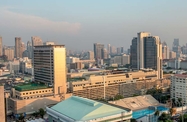A slow-paced economic recovery and ongoing concerns over political stability were the hallmark of Thailand’s year in 2016, though the new year should bring stronger prospects.

Changes abound
Thailand closes out 2016 under something of a cloud, mourning the death of long-reining monarch King Bhumibol Adulyadej on October 13. Having ruled for 70 years, the passing of the 88-year-old head of state has added another element of uncertainty to the current social and economic environment, with the king often having provided a stabilising hand in troubled times.
In early November the Bank of Thailand (BOT), the central bank, warned there were greater downside risks facing the national economy on both the domestic and foreign fronts, though at the same time reaffirming that overall prospects for growth remain solid.
Announcing its intention to leave the benchmark rate unchanged at 1.5%, a level the monetary policy committee said was accommodative for growth, the bank forecast the economy would expand at a rate close to previous predictions.
In late October the bank forecast GDP would increase by 3.2% this year, up from 2.8% last year, with a similar level of expansion forecast for 2017 – figures in line with IMF expectations for growth.
“The committee saw the need to preserve policy space given that the Thai economy would still be facing greater uncertainties going forward, particularly the fragile global economic recovery and uncertainties in the monetary policy directions of major advanced economies that might induce greater capital flow and exchange rate volatility,” the bank said in a statement.
Some of that uncertainty was domestic, with the BOT citing local risk factors that needed to be monitored, including deteriorating loan quality in the business sector and rising inflation.
Further from home, the bank highlighted uncertainties stemming from political developments in the US and Europe, and falling tourist arrivals from key markets such as China as factors that pose risks to economic recovery.
Uncertain sentiment
The death of King Bhumibol cast a pall over the economy late in the year, with his passing cited as one of the reasons consumer sentiment dipped at the beginning of the fourth quarter. The University of the Thai Chamber of Commerce’s consumer confidence index eased from 74.2 in September to 73.1 in October and 72.3 in November, reversing three months of increases.
Weak economic and jobs growth combined with low commodity prices also had an impact on sentiment, the university said, with consumers set to remain cautious on spending at least until the new year.
Business confidence also slipped in the fourth quarter, with the BOT reporting its business sentiment index fell from 50.3 in September to 49.5 in November, dipping below the 50-point threshold that indicates positive sentiment.
The three-month business outlook was more upbeat at 54.5, albeit down slightly from 54.7 in September.
Credit growth cools
Another indicator of more cautious consumer and business sentiment was bank lending, which slowed throughout the year.
According to data issued by the BOT in mid-November, Thailand’s banks were on track to see their loan portfolios expand by between 2% and 3% this year, below the 4.3% posted in 2015.
In the third quarter lending rose by 2.3% year-on-year (y-o-y), the slowest pace since 2010, with the reduced rate of growth due to a slower-than-expected economic recovery, the bank said.
Lending to the corporate sector, which accounts for roughly two-thirds of bank loan activity, was even slower, rising by just 1.1% y-o-y in the third quarter.
In a similar vein, the ratio of non-performing loans increased in the third quarter to 2.9% of banks’ total loan portfolios, up from 2.72% in the second quarter and the highest rate in five years.
Industrial activity steadies
Closing out the third quarter, Thailand’s manufacturing sector saw a marginal increase in activity, with the manufacturing production index up 0.6% y-o-y in September.
While slower than the 3.18% y-o-y increase posted in August, the September result signalled two consecutive months of growth on the index, supported by higher export demand for industrial goods. Indeed, growth in exports was recorded for the first time in seven quarters in the July-to-September period.
Capacity utilisation was also up in September, with 65.2% of industrial plants in use, up from 64.4% in August.
Although growth was expected to ease in the last quarter of the year, with manufacturing projected to be the hardest hit during the first 30 days of the 12-month mourning period following the king’s death, a rebound is possible in 2017.
Much will ultimately depend on the health of the global economy, as the sector is likely to remain largely dependent on export growth to compensate for sluggish domestic demand.
Oxford Business Group is now on Instagram. Follow us here for news and stunning imagery from the more than 30 markets we cover.


